
The University of Charleston (UC) is a private non-profit university with its main campus in Charleston, West Virginia. The university also has a location in Beckley, West Virginia, known as UC-Beckley.
West Virginia Route 45 is a state highway in the U.S. state of West Virginia. The state highway runs 25.8 miles (41.5 km) from the Virginia state line near Glengary east to WV 230 and WV 480 in Shepherdstown. WV 45 connects the communities of Glengary and Arden in southwestern Berkeley County with the county seat of Martinsburg. The state highway also connects Shepherdstown in northern Jefferson County with Martinsburg, where the highway meets Interstate 81 (I-81), U.S. Route 11, and WV 9.
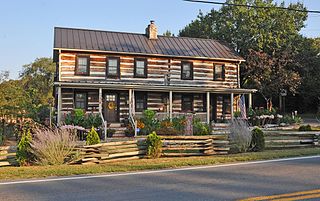
Darkesville is an unincorporated community in Berkeley County, West Virginia, United States. Established in 1791, Darkesville has been nationally recognized as a historic district.

The West Virginia State Capitol is the seat of government for the U.S. state of West Virginia, and houses the West Virginia Legislature and the office of the Governor of West Virginia. Located in Charleston, West Virginia, the building was dedicated in 1932. Along with the West Virginia Executive Mansion it is part of the West Virginia Capitol Complex, a historic district listed on the National Register of Historic Places.
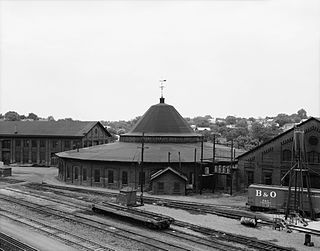
Baltimore and Ohio Railroad Martinsburg Shops is a historic industrial district in Martinsburg, West Virginia. It is significant both for its railroading architecture by Albert Fink and John Rudolph Niernsee and for its role in the Great Railroad Strike of 1877. It consists of three contributing buildings, one of which is the oldest covered roundhouse in the United States. The presence of the Baltimore and Ohio Railroad Company in Martinsburg dates back to the late 1840s, when the first engine and machine shops were erected for the expanding company.

The Federal Aviation Administration Records Center in Martinsburg, West Virginia is the former United States Courthouse and Post Office for the city. It is a Richardson Romanesque style building, principally designed by Willoughby J. Edbrooke, of the Office of the Supervising Architect. It was used as a federal courthouse and post office from 1895 to 1961, when both functions moved across the street to a new facility. The building to some extent resembles Henry Hobson Richardson's now-destroyed Cincinnati Chamber of Commerce Building.

The Apollo Theatre in Martinsburg, West Virginia was designed by architect Reginald Geare with local architect Chapman E. Kent, and built in 1913 by theater owner H. P. Thorn. As constructed it had a seating capacity of 1000, and was used for movies, vaudeville and concerts. Upper floors provided meeting spaces for large groups.
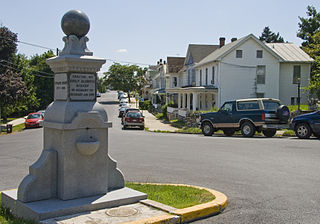
The Boomtown Historic District comprises the western and southern portions of Martinsburg, West Virginia, generally along the alignments of West King Street and Winchester Avenue, following the general path of the town's electric streetcar system. It includes a former industrial section of the town, home to a number of textile mills, as well as the housing that was built for mill workers.

The Boydville Historic District includes an area of Martinsburg, West Virginia that was developed for the well-to-do of Martinsburg at the turn of the twentieth century. The district is named for Boydville, the mansion at the core of the district. The district runs generally along South Queen Street to the south of the Downtown Martinsburg Historic District and to the east of the Boomtown Historic District.
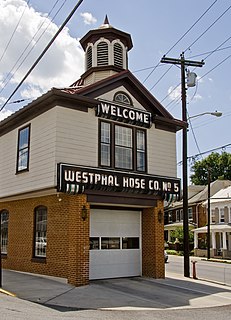
The East Martinsburg Historic District is associated with the growth of Martinsburg, West Virginia during the 1850s, when the development of the Baltimore and Ohio Railroad brought German and Irish settlers to the area. The district includes areas known as Buena Vista, Chevally City, St. Vincent, Hooge's Addition, Small's Addition, Carver's Addition, Mohler's Addition, Strinesville and East Strinesville.

The Baltimore and Ohio Related Industries Historic District comprises a portion of Martinsburg, West Virginia to either side of the Baltimore and Ohio Railroad line as it runs through the city. The district includes the Baltimore and Ohio Railroad Martinsburg Shops, a National Historic Landmark, and a variety of industrial and commercial concerns that depended on the railroad.

South Water Street Historic District is a national historic district located at Martinsburg, Berkeley County, West Virginia. It encompasses 30 contributing buildings and one contributing site, related to residential, commercial, and economic development along the Tuscarora Creek. Notable buildings include: the Edison Electric Illumination Company of Martinsburg building; dwellings along South Water Street at 104–106, 108, 119, 120, 200, 202, 208, 216, and 308; rowhouses at 222, 224, and 226; the O'Hara-Martin House ; the Alburtis House; the South Water Street Stone House ; the Martinsburg Steam Laundry Company building; and Martinsburg Gas Company Complex. Also located in the district is the separately listed General Adam Stephen House.

Spring Mills Historic District is a national historic district located near Martinsburg, Berkeley County, West Virginia. It encompasses five contributing buildings, constructed between about 1790 and 1922, and two contributing sites. They include the Falling Waters Presbyterian Church (1834) and Manse (1922) and Stephen Hammond Mill, Miller's House, and Spring House. The buildings are of masonry construction. The sites are the Falling Waters Presbyterian Church Cemetery and the site of Dr. Allen Hammonds House.
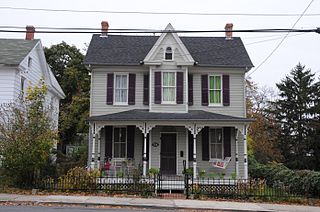
Martinsburg Mining, Manufacturing & Improvement Co. Historic District is a national historic district located at Martinsburg, Berkeley County, West Virginia. It encompasses 289 contributing buildings located within 19 city blocks and built between 1891 and 1952. It includes a residential area developed by the Martinsburg Mining, Manufacturing & Improvement Co. as worker housing. They are one to 2 1/2 story, single family, detached, semi-detached, and multi-unit housing built in wood frame, brick or brick veneer, and concrete block. Also located in the district is the Gothic Revival-style St. Luke's United Methodist Church. It includes examples of vernacular interpretations of popular architectural styles including Queen Anne, American Four Square, and Bungalow styles.

North Street Historic District is a national historic district located at New Martinsville, Wetzel County, West Virginia. It encompasses 23 contributing buildings that include a residential and commercial area of New Martinsville. Most of the buildings in the district date to the late-19th and early-20th century in popular architectural styles, such as Stick Style, Queen Anne, and American Foursquare. Notable buildings include the Old Hospital Building, New Martinsville Grocery Company and warehouse (1895), former Cottage Hotel (1890), and the Moose Club.

West Martinsburg Historic District is a national historic district located at Martinsburg, Berkeley County, West Virginia. It encompasses 138 contributing buildings constructed between about 1900 and 1956. It is primarily residential and many of the earlier houses in the district represent the “small house” movement of the 1920s and 1930s. The houses reflect popular architectural styles from the first half of the 20th century including the Bungalow, American Craftsman, American Foursquare, and Colonial Revival styles.
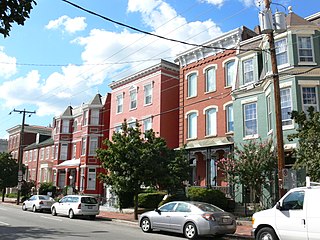
The Block 0-100 East Franklin Street Historic District is a national historic district located at Richmond, Virginia. It is located west of downtown. The district encompasses 21 contributing buildings built between about 1840 and 1920. The district is characterized by numerous mid- to late-19th century brick town houses in a variety of popular 19th-century architectural styles including Queen Anne, Italianate, and Greek Revival.

The Carver Industrial Historic District is a national historic district located at Carver, Richmond, Virginia. The district encompasses 13 contributing buildings located west of downtown Richmond. The industrial area developed between 1890 and 1930, along the tracks of the Richmond, Fredericksburg and Potomac Railroad. The buildings are in a variety of popular 19th-century and early 20th century architectural styles including Queen Anne and Romanesque.

The Laburnum Park Historic District is a national historic district located at Richmond, Virginia. The district encompasses 226 contributing buildings and 2 contributing structures located north of downtown Richmond. The primarily residential area developed starting in the early-20th century as one of the city's early "streetcar suburbs" and as home to several important local institutions. The buildings are in a variety of popular early-20th century architectural styles including Queen Anne and Colonial Revival. It was developed as neighborhood of middle-to-upper-class, single-family dwellings. Notable buildings include the Laburnum House (1908), Richmond Memorial Hospital (1954-1957), Richmond Memorial Hospital Nursing School (1960-1961), "The Hermitage" (1911), Laburnum Court (1919), Veritas School.





















